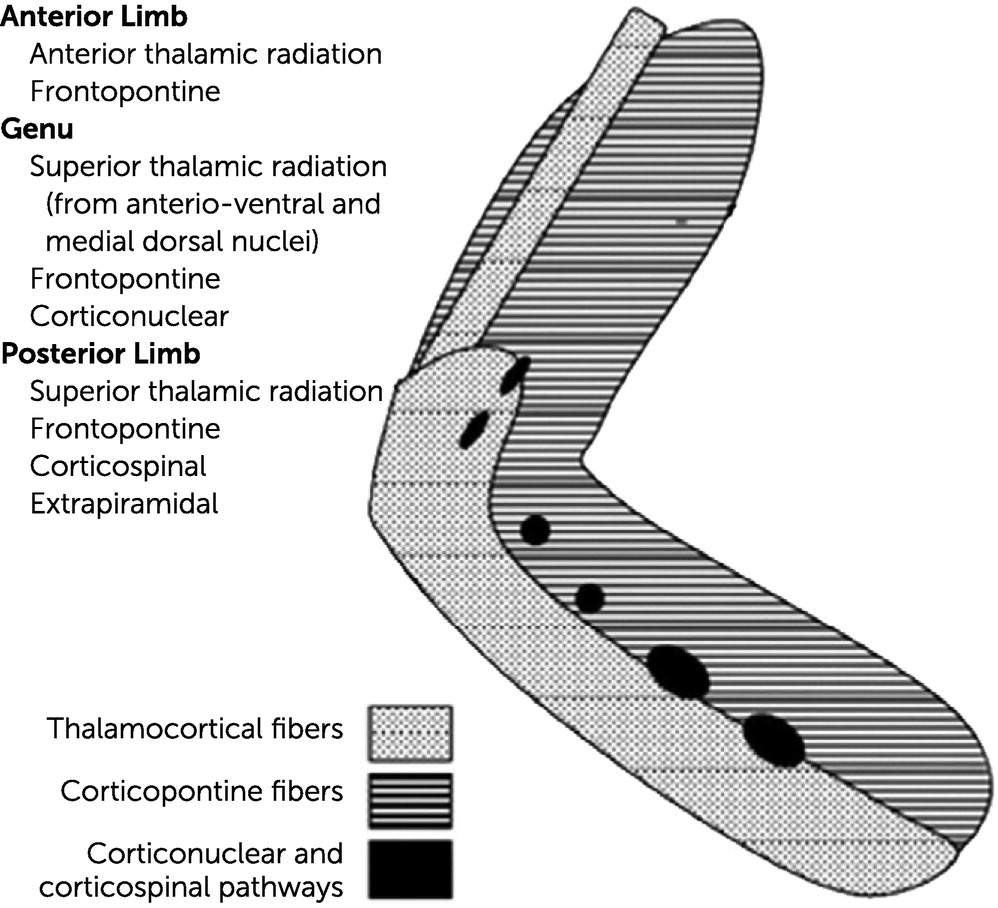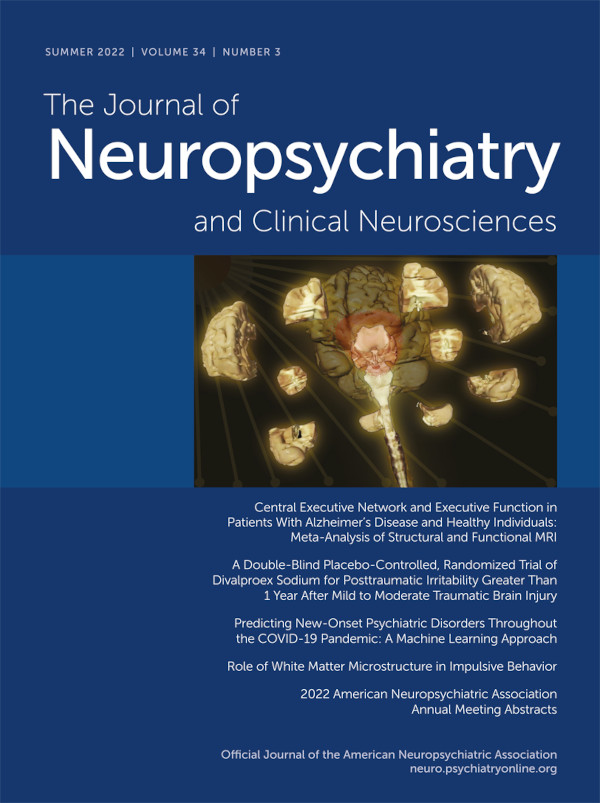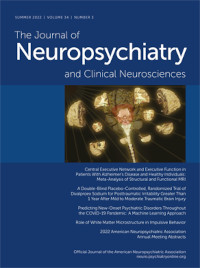Exploring Cognitive Impairment in Patients With Bilateral Capsular Genu Lesions
Abstract
Objective:
Methods:
Results:
Conclusions:

Methods
Patient Selection and Imaging
Neuropsychological Assessment
Results

| Neuropsychological assessmentb | Patient 1 | Patient 2 | Patient 3 | Patient 4 | Patient 5 | Patient 6 | Patient 7 | Patient 8 | ||||||||||
|---|---|---|---|---|---|---|---|---|---|---|---|---|---|---|---|---|---|---|
| Mean | SD | Mean | SD | Mean | SD | Mean | SD | Mean | SD | Mean | SD | Mean | SD | Mean | SD | Mean | SD | |
| Education level (years) | 10.0 | 12.0 | 5.0 | 12.0 | 8.0 | 5 | 11.0 | 15.0 | ||||||||||
| Global mental assessment | ||||||||||||||||||
| Mini-Mental State Examination | 27.0 | 1.6 | 16.0 | –6.88c | 23.0 | –2.50 | 24.0 | –1.88 | 20.0 | –4.38c | 18.0 | –5.63c | 17.0 | –6.25c | 24.0 | –1.88 | 23.0 | –2.50 |
| Stroop test | ||||||||||||||||||
| Name color print of noncolor words | 24.0 | 8.0 | 84.0 | 7.50c | 56.0 | 4.00c | 54.0 | 3.75c | 80.0 | 7.00c | 94.0 | 8.75c | 85.0 | 7.63c | 48.0 | 2.25 | 60.0 | 2.75 |
| Name color print of color words | 37.0 | 14.0 | 90.0 | 3.79c | 75.0 | 2.71 | 65.0 | 2.00 | 98.0 | 4.36c | 104.0 | 4.79c | 94.0 | 4.07c | 64.0 | 1.93 | 81.0 | 3.13c |
| Trail-Making Test | ||||||||||||||||||
| Part A | 38.0 | 12.0 | 78.0 | 3.33c | 66.0 | 3.17c | 52.0 | 1.17 | 72.0 | 2.83 | 78.0 | 3.33c | 82.0 | 3.67c | 60.0 | 1.83 | 76.0 | 3.17c |
| Part B | 91.0 | 55.0 | 270.0 | 3.25c | 210.0 | 2.16 | 220.0 | 2.35 | 260.0 | 3.07c | 280.0 | 3.44c | 290.0 | 3.62c | 220.0 | 2.35 | 290.0 | 3.62c |
| Token test | 32.4 | 2.1 | 26.0 | –3.05c | 28.0 | –2.10 | 31.0 | –0.67 | 22.0 | –4.95c | 26.0 | –3.05c | 21.0 | –5.43c | 30.0 | –1.14 | 24.0 | –4.00c |
| Controlled Oral Word Association | 17.0 | 3.0 | 7.0 | –3.33c | 14.0 | –1.00 | 12.0 | –1.67 | 6.0 | –3.67c | 8.0 | –3.00c | 6.0 | –3.67 | 14.0 | –1.00 | 13.0 | –1.33 |
| Neuropsychological assessmentb | Patient 1 | Patient 2 | Patient 3 | Patient 4 | Patient 5 | Patient 6 | Patient 7 | Patient 8 | ||||||||||
|---|---|---|---|---|---|---|---|---|---|---|---|---|---|---|---|---|---|---|
| Mean | SD | Mean | SD | Mean | SD | Mean | SD | Mean | SD | Mean | SD | Mean | SD | Mean | SD | Mean | SD | |
| Wisconsin Card-Sorting Test | ||||||||||||||||||
| Categories achieved | 4.1 | 1.0 | 1.8 | –2.30 | 4.3 | 0.20 | 3.6 | –0.50 | 1.2 | –2.90 | 0.9 | –3.20c | 0.6 | –3.50c | 3.5 | –0.30 | 3.9 | –0.10 |
| Correct responses | 66.0 | 8.0 | 34.0 | –4.00c | 48.0 | –2.25 | 45.0 | –2.63 | 22.0 | –5.50c | 32.0 | –4.25c | 26.0 | –5.00c | 58.0 | –1.00 | 48.0 | –2.25 |
| Errors | 42.0 | 10.0 | 72.0 | 3.00c | 75.0 | 3.30c | 68.0 | 2.60 | 90.0 | 4.80c | 76.0 | 3.40c | 86.0 | 4.40c | 62.0 | 2.00 | 54.0 | 1.20 |
| Perseverative responses | 20.0 | 13.0 | 75.0 | 4.23c | 49.0 | 2.23 | 48 | 2.15 | 63.0 | 3.31c | 76.0 | 4.31c | 72.0 | 4.0c | 46.0 | 2.0 | 60.0 | 3.08c |
| Inability to maintain memory | 0.9 | 0.6 | 3.0 | 3.50c | 1.2 | 2.17 | 1.9 | 1.67 | 3.2 | –3.83 | 2.8 | 3.17c | 3.4 | 4.17c | 1.4 | 0.83 | 2.6 | 2.83 |
| Working memory (short-term memory), trial 1, list A | 6.3 | 1.2 | 2.0 | –3.58c | 4.5 | –1.50 | 4.0 | –1.92 | 2.2 | –3.42c | 2.4 | –3.25c | 1.9 | –3.67c | 5.2 | –0.92 | 4.2 | –1.75 |
| Short-term memory, digit span forward | 4.4 | 0.8 | 1.5 | –3.63c | 4.2 | –0.25 | 4.0 | –0.50 | 1.5 | –3.63c | 1.8 | –3.25c | 1.0 | –4.25c | 3.4 | –1.25 | 1.8 | –3.25c |
| Verbal memory, delayed recal | 10.2 | 2.1 | 3.0 | –3.43c | 7.0 | –1.52 | 8.0 | –1.05 | 3.0 | –3.43c | 4.0 | –2.95 | 3.0 | –3.43c | 6.0 | –2.0 | 5.0 | –2.48 |
| Recognition | 11.1 | 2.2 | 4.0 | –3.23c | 6.0 | –2.32 | 8.0 | –1.41 | 5.0 | –2.77 | 4.0 | –3.23c | 3.0 | –3.68c | 5.0 | –2.77 | 5.0 | –2.77 |
| Visual memory/visual memory span | 17.6 | 2.8 | 13.0 | –1.64 | 14.0 | –1.29 | 13.0 | –1.64 | 11.0 | –2.36 | 9.0 | –30.7c | 9.0 | –3.07c | 16.0 | –0.57 | 12.0 | –2.0 |
| Copy drawings | 12.8 | 1.8 | 7.0 | –3.22c | 12.0 | –0.44 | 11 | –1.0 | 7.0 | –3.22c | 6.0 | –3.78 | 6 | –3.78 | 11.0 | –1.0 | 10.0 | –1.56 |
| Counting, writing, and reading | 10.0 | 1.4 | 5.0 | –3.57c | 7.0 | –2.14 | 9 | –0.71 | 5.0 | –3.57c | 6.0 | –2.86 | 6.0 | –2.86 | 9.0 | –0.71 | 6.0 | –2.86 |
Discussion
Footnote
References
Information & Authors
Information
Published In
History
Keywords
Authors
Funding Information
Metrics & Citations
Metrics
Citations
Export Citations
If you have the appropriate software installed, you can download article citation data to the citation manager of your choice. Simply select your manager software from the list below and click Download.
For more information or tips please see 'Downloading to a citation manager' in the Help menu.
View Options
View options
PDF/EPUB
View PDF/EPUBLogin options
Already a subscriber? Access your subscription through your login credentials or your institution for full access to this article.
Personal login Institutional Login Open Athens loginNot a subscriber?
PsychiatryOnline subscription options offer access to the DSM-5-TR® library, books, journals, CME, and patient resources. This all-in-one virtual library provides psychiatrists and mental health professionals with key resources for diagnosis, treatment, research, and professional development.
Need more help? PsychiatryOnline Customer Service may be reached by emailing [email protected] or by calling 800-368-5777 (in the U.S.) or 703-907-7322 (outside the U.S.).

